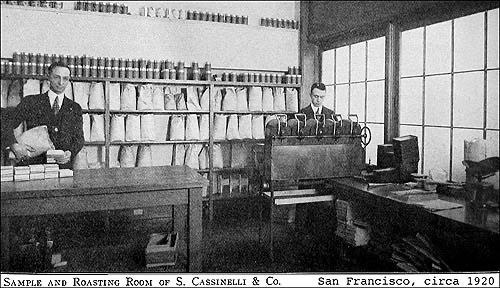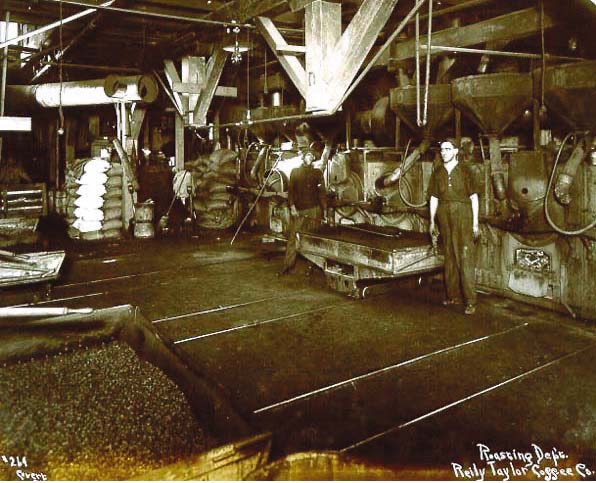Quoted from "Coffee As It Is And As It Ought To Be" (1850)
Book scans courtesy of Sweet Maria coffee company
"The process of roasting coffee is very simple, and occupies but twenty minutes. I have heard that persons have actually cooked this Arabian dainty in a frying-pan, and smothered it in butter, to keep it from burning. Oh, the pity of it! Who can be surprised that the results of such an ungainly, antediluvian method should be otherwise than delightful. It is nearly as barbarous as serving up tea-leaves with melted butter, of which a story is somewhere told, instead of drinking the decoction.
In private families, where this beverage is taken once a day, a coffee-roaster must be provided, which will contain a pound of the raw berries, although only two-thirds of that quantity should be put into it; as, in the operation of roasting, they will swell to nearly one-third more than the space they occupy when raw, and room must be given them to move about and be well shaken, during the process.
These domestic utensils, although not common, are to be purchased at any furnishing ironmongers. They are of iron, cylindrical shaped, and of various sizes; those which will contain a pound of raw coffee are about four inches wide, and seven in length, with a small sliding-door, also of iron, having a ledge by which it can be opened and shut, by means of a pair of pincers, or even by tapping it with any convenient article, such as a pocket-knife. In the middle of this cylinder, at one end, is fixed an iron handle, about eight inches long, and hollow, into which a round wooden handle is fastened, two feet in length.
Having made a clear fire below the upper bar of the grate, so as to admit of the action of rolling the roaster backwards and forwards along the top, without impediment, put into the machine as much raw coffee as will rather more than three parts fill it, and commence roasting, by turning the handle quickly and incessantly, though not velociously.
If this rotatory motion be stopped, a snapping noise will be heard. This is caused by the berries being unequally roasted: those at the bottom will be burning, while others are not exposed to any heat. The rolling backwards and forwards, therefore, must not be discontinued, except while another motion is substituted, which is, to lift the roaster up now and then, and shake it the contrary way, in order more thoroughly to intermix and change the position of the berries, so that the process may pro ceed equally.
The great secret to obtain fine flavoured coffee is to prevent the escape of the aroma; hence, the roaster should be opened as seldom as possible; and, for a quarter of an hour, it will be wholly unnecessary. As the process draws to a close, however, it will be requisite to investigate its progress; but this must be done quickly. No kind of manual dexterity is acquired at once ; but practice will soon render this as easy and certain as any other. On no account must any butter or other extraneous matter be introduced; coffee exudes an essential oil, which will prove the best, as it must be the only, medium in the process.
In a quarter of an hour the little door should be opened, and the state of the berries inspected. If they look brown, but of various shades, the heat has not been equally disseminated; and the roaster must be well shaken for half a minute, and then replaced on a cooler part of the fire, on the top bar, to finish gradually, still being rolled and shaken alternately.
As twenty minutes is the time in which a batch will be finished, with proper management, it must be looked at once or twice more; when the eye, as well as sense of smell, will soon acquire experience in deciding whether the operation is finished. It must now be taken off the fire; but, as there is naturally a great body of heat still remaining in the cylinder (sufficient, indeed, to burn the berries), it must not be left; but should be shaken for two or three minutes away from the fire, in order that, while it cools gradually, all that fine aroma, on which depends the spirit, flavour, and excellence of coffee, may be imbibed, instead of being lost by opening and emptying the roaster while any heat remains.
As soon as it is cold, it must be poured into a glass bottle or canister, as before mentioned, and kept close stopped for use. Coffee wastes, in roasting, about two ounces in the pound. Coffee undergoes important changes in the process of roasting. When it is roasted to a yellowish brown, it loses, according to Cadet, 12 percent, of its weight, and is in this state difficult to grind; when roasted to a chesnut-brown, it loses 18 per cent. ; and when it becomes entirely black, though not at all carbonised, it has lost 23 per cent.
When it loses more than 20 per cent of its weigh in roasting, coffee is sure to be injured. Bernier says, when he was at Cairo, where coffee is so much used, he was assured by the best judges, that there were only two people in that great city who understood how to prepare it in perfection.

If it be under-roasted, its virtues will not be imparted, and in use it will load and oppress the stomach; if it be over-done, it will yield a fiat, burnt and bitter taste, its virtues will be destroyed, and in use it will heat the body and act as an astringent.
Those who have not facilities for roasting the berries themselves, should employ one or other of the leading coffee-roasters of the metropolis, who, from their extensive premises, improved patented machinery, and great experience, may be safely entrusted with the preparation of the berry.
Messrs. James Collier and Son, of Foster-street, Bishopsgate, the oldest coffee-roasters in the metropolis, who have devoted much attention to the id subject, have patented an improved apparatus for roasting, sifting, and cooling coffee.

The construction of their cylinder is quite different from any other, being made of a description of metal not before adopted for roasting coffee — the internal part of which is thickly cased with enamel. The first object is cleanliness — the next is equally important, by preventing the coffee, while roasting, being impregnated with impurities of irony or sulphurous effluvia passing into the cylinder, which is not obviated by the general use of common plate-iron roasters worked over charcoal fires. Enamelled circular tubes pass through these cylinders, to convey an equal temperature of heat, and intersect the coffee while in revolving motion.
Dispersers (commonly called breakers) are so constructed and ingeniously arranged, as to sift the coffee while roasting, by which means all the acidity and rancid impurities of the raw coffee are emitted by evaporation, and the dust or flights removed from the cylinder through apertures, while the fine aromatic and nutritious qualities of the coffee are preserved. When the coffee is sufficiently roasted in these enamelled cylinders, it possesses that beautiful bright appearance so much approved.
The hot coffee is then discharged into strong wire cylindrical coolers, which are immediately set to work in revolving motion by steam power, and, if necessary, by the application of forced atmospheric air dispersed into the revolving cooling cylinders, through the tubular perforated spindle. By this new invention, the heat is extracted from the coffee, and it becomes sufficiently cold in about twenty minutes (at any period of the year), so that it is fit to grind for immediate use, or to be close packed for country orders.
The important advantages of roasted coffee being properly cooled, previous to grinding, closely packed in chests, or stored away into canisters, is obvious. The essential or aromatic oil is retained in the berries, and the bright complexion of the coffee is preserved, without heating or discolouration.”
Begun November 13 2019